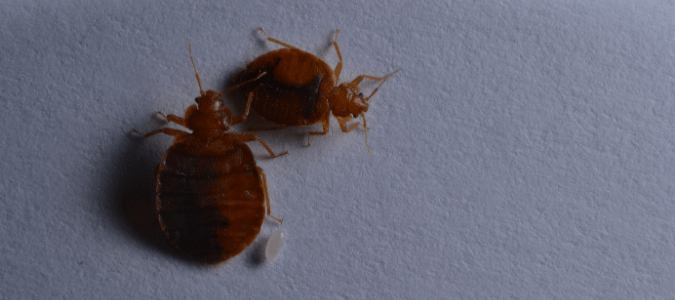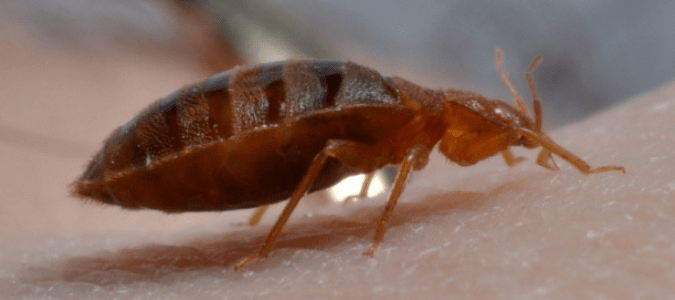The dreaded words “bed bugs” can make any homeowner shiver. Bed bugs feed on human and animal blood, usually while we sleep, and can hide in furniture, behind wallpaper and in other hard-to-reach places. If you have started getting itchy bites at night, you might wonder whether you have these pests. Bed bugs are tiny pests that can be hard to spot, so you must inspect thoroughly to spot signs of them.
Bed bugs are a more common problem than many people think. Knowing how to inspect for bed bugs can help you determine whether or not you’re dealing with an infestation.
What To Look For and Signs You Have Bed Bugs
Bed bugs are tiny, oval-shaped insects. They are about the size and shape of an apple seed with a reddish-brown coloration. Bed bug bodies have a banded appearance due to the ridges along their wings. Adult bed bugs’ heads are elongated with antennae on each side and small eyes at the front of the head.
On closer inspection of your furniture, you may also see small dark spots on the sheets or mattress where bed bugs have excreted their waste.
Other signs may include bites on the skin that may cause itching and irritation. However, it’s also important to note that everyone will react differently to bites. Some people may not react at all! Homeowners who do react to bites might notice that they are getting bitten at night but don’t see signs of bed bugs. Inspect your sheets regularly and pay attention to dark crevices near your furniture or bed frame.
Some of these signs are also harder to spot, like the bed bug casings and eggs. The color and size of the casings can vary depending on how old the bugs are. This is because they change in size as they mature.
Bed bugs usually lay their eggs near the sleeping area they inhabit. Bed bug eggs are yellowish-brown or translucent, and they are about the size of a pinhead. Bed bug eggs may be near your bed, mattress or other furniture.
Now that you know what to look for, let’s review where to look around your bed.
How To Check Your Bed for Bed Bugs
Before inspecting your bed for bed bugs, grab a credit card and wrap a piece of tape around it. Bed bugs can hide in crevices the width of a credit card. You can use the credit card with a piece of tape to reach tiny cracks and crevices and pull out bed bugs, their eggs and their casings.
Start your inspection by looking at your sheets, pillows, blankets, comforters and anything else on your bed for any tiny red dots that could be fecal stains left behind by bed bugs. Then, throw these items in the wash on high heat. The heat from the washing and drying machine can help with any bed bugs that might be hiding in these items.
Next, pull your bed away from the wall. This will make your inspection easier and can also expose any bed bugs that might be hiding there. Use your sticky credit card along the folds and seams of your mattress to see if anything pops up or sticks to the tape. Look for any bed bugs, stains, eggs or casings. Then, take your mattress off your box spring or bed frame. If you have a box spring, inspect it like you did with your mattress. Finally, use your sticky credit card in any of the crevices in your bed frame and headboard to see if you can find any evidence of bed bugs.
As you can tell, inspecting for bed bugs can be a time-consuming project. Bed bug control experts will be able to efficiently inspect your home for these pests. Pest control professionals have the tools, knowledge and capabilities needed to treat these pests.
Why Bed Bugs Are Difficult to Control
These pests can be challenging to control because of a few key factors, including their size, resilience and reproductive capabilities.
Bed bugs are usually about the size of an apple seed, making them difficult to see. This can make identifying bed bugs a significant challenge and allow the infestation to spread before treatment begins.
They can live in various climates and conditions by hiding in tiny crevices equivalent to a credit card’s thickness. Bed bug eggs can survive without food and remain dormant for up to 10 months if the conditions are right. A female bed bug can lay over 100 eggs in her lifetime.
Ultimately, it’s best to contact a pest control expert who can implement a bed bug control plan.
How To Check for Bed Bugs in a Hotel
Bed bugs are known to travel with guests, so knowing how to check for them before getting settled in your room will make it less likely that they come home with you.
Here are some ways to check for bed bugs in a hotel to ensure there isn’t a bed bug problem:
- Look for dark spots around the seams of the mattress and box spring, as this could be the first noticeable sign of bed bug activity.
- Then, search under furniture and crevices or nooks in walls, headboards, mattress seams and behind curtains. Look for traces of bed bug excrement or if you can find these critters yourself. They can easily hide in small places.
- Before placing your suitcase down, look inside wardrobes, cabinets and luggage racks before unpacking them.
To be extra cautious, after inspecting the room and finding no visible sign of bed bugs present, use luggage racks to keep your luggage off the floor. This way, if there are any bed bugs, it will be difficult for them to climb in your luggage and travel home with you.
But, if there are no traces after a thorough examination, then there probably isn’t an active bed bug infestation inside the hotel.
What To Do if You Find Bed Bugs
Contact the hotel staff immediately if you find signs of bed bugs during your stay. Request a new room in the hotel to reduce your risk of carrying them home. Then, run your clothing for 20 to 30 minutes in a hot dryer. Hot water washing is not necessary. Dry the clothing first and then wash at whatever temperature you prefer. Inspect your luggage carefully and store it in the garage or the attic, just in case.
After you’ve reported an infestation to hotel staff, they should respond quickly and arrange for professional bed bug control services to treat the room and surrounding areas.
Contact ABC to Resolve Your Bed Bug Problem
Bed bugs are difficult to remove once they’ve infested an area. Once you’ve identified the signs of an infestation, contact ABC Home & Commercial Services to help treat your bed bug problem.


